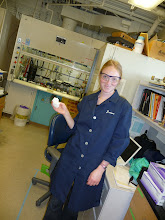Ever wonder why fireflies are so... fiery? Or how they decide when to glow and when not to glow?
The purpose of a firefly's glow is speculated to be two-fold: at the larval stage, fireflies (also called lightning bugs) emit a glowing light in order to fend off potential predators by tricking them into thinking that their prey is poisonous; adult fireflies, on the other hand, light up in order to attract mates. The adult "flash pattern" is specific to the species: some species use a continuous pulse flash, whereas others produce a single, brief flash.
So what chemical reaction is responsible for the glow?
A chemical known as "firefly luciferin," shown below, reacts with oxygen under enzyme catalysis by "flirefly luciferase," magnesium ion and Adenosine Triphosphate (ATP) to form a dioxetanone intermediate. Decomposition of the dioxetanone produces electronically excited oxyluciferin. Relaxation of oxyluciferin to its ground state is accompanied by emission of yellow light (maximum wavelength 560 nm, quantum yield 0.88, which is quite high!--compare to the bright green material in the vial shown on the side of this page, which has a quantum yield of only 0.33).






No comments:
Post a Comment